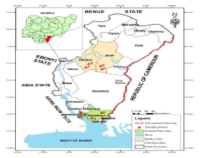Surface charge characteristics of coastal plain soils in Cross River State, Nigeria.
Main Article Content
Abstract
Physico-chemical and Point of Zero Charge (PZC) of coastal plain soils of Cross River State, Nigeria were studied. Four profiles representing coastal plain soils were studied in Calabar South and Akpabuyo Local Government Areas. The soils were coarse-texturedwith high sand content exceeding 70 % in the surface, giving surface textural classes of loamy sand or sandy loam overlying sandy clay and sandy clay loam subsurface.The soils were characterized as follows: soil reaction, very strongly acid (pH 4.0 -4.5), mean organic carbon contents of 1.98 % for surface soils, available P (29.31mgkg-1),effective cation exchange capacity (ECEC) was low (2.36-6.26 cmolkg-1); base saturation (65 -74 %) The ΔpH values (pH in KCl –pH in H2O) were negative with mean values of –0.63 and –1.01 for surface and subsurface of coastal plain soils. PZC values were 3 and 3.9 for Calabar and Akpabuyo soils, indicating that the PZC values were typical of natural soils. These findings revealed that surface charge depends on the activities of potential determining ions (H+and OH-) and electrolyte concentration (ionic strength), in the soil. With the negative delta pH (ΔpH) values in all the horizons, the coastal plain soils are negatively charged.
Downloads
Article Details
Issue
Section

This work is licensed under a Creative Commons Attribution-NonCommercial-ShareAlike 4.0 International License.
How to Cite
References
Aki, E. E., Esu, I. E. &Akpan-idiok, A. U. (2014). Pedological study of soils developed on biotic-hornblende- gneiss in Akampka Local Government Area of Cross River State, Nigeria. International Journal of Agricultural Research, 4: 187-199.
Akpan–Idiok, A. U. (2012). Physiochemical properties, degradation rate and vulnerability potential of soils formed on coastal plains sands in South East Nigeria. International Journal of Agricultural Research, 7: 358-366.
Akpan-idiok, A. U. & Ukwang, E. E. (2012). Characterization and classification of coastal plain soils in Calabar, Nigeria. Journal of Agriculture Biotechnology. Economics, 5: 19-33.
Appel, C. & Ma, L. Q.(2003). Concentrations of pH and surface charge effects on Cd and Pd sorption in three tropical soils. Journal of Environment Quality, 31: 581-589.
Black, C. A. (1965). Method of soil analysis: Agronomy 9. Madison Wisconsin, 914-925.
Bray, R. H. & Kurtz, L. T. (1945). Determination of total organic and available forms of phosphorus in soils. Soil Science, 59; 39-45.
Enwezor, W. O., Udo, E. J. & Sobulo, R. A. (1981).Fertility status and productivity of the “acid sands”. In: Udo, E. J. and Sobolu, R. A, (Eds.) acid sands of Southern Nigeria. Soil Science Society of Nigeria.Special publs. Monography, 1: 56-73.
Esu, I. E., Akpan-idiok, A. U. & Eyong, M. O. (2008). Characterization and classification of soils along a typical hill slope in Afikpo area of Ebonyi State, Nigeria. Nigerian Journal of Soil and Environmental Resources, 8:1-16.
Fertilizer Procurement and Distribution Division. (1990). Literature review on soil fertility investigations in Nigeria fertilizer procurement and distribution division, Federal Ministry of Agriculture and Natural Resources, Lagos Nigeria.
Holland, M. D. G., Barton, A. D. & Morph, S.T. (1989). Land evaluation agriculture recommendation of Cross River State National Park. Oban
Division, prepared by Odioki, in collaboration with INNF.
Jackson, M. I. (1989). Soil chemical analysis. Advance course (2), Department of Soil Science. University of Wisconsin, United States of America.
Juo, A. S. R. (1981). Mineralogical characteristics of alfisols and utisols with variable change “acid sands of Southern Nigeria,” Ibadan: Soil Science Society of Nigeria, 26-35.
Loganathan, P. & Fernando, T. W. (1977). Surface charge characteristics of some acid soils of Sri Lanka. Soil Science Society of Ceylon. 97-107.
Maclean, E. O. (1982). Aluminum. In: C. A. Black (Ed.), Methods of soil analysis: Part II. Madison: American Society of Agronomy, 988.
Mckaegue, J. A. & Day, J. H. (1996). Dithionate and Oxalate-extractable Feand Al as aids in differentiating various classes of soil. Canadian
Journal of Soil Science, 46: 13-22.
Metson, P. A, Vitousek, P. M, Evel, J. J, Mazzarino, M. J. & Robertson, G. P. (1987). Nitrogen cycling following land clearing in a premature wet
tropical forest near Turrialba, Costa Rica. Ecology, 68: 491-502.
Moghimi, A. H., Hamdan, I. J., Shamshuddin, I. A. W., Samsuri, L. & Abtahi, A. (2013).Physio-chemical properties and surface Charge characteristics of arid soils in southeastern Iran.
Murphy, J. & Riley, J. P. (1962). A modified single solution method for the determination of phosphorus in natural waters. Annuals of chemical Acta, 2; 27-35.
Page, A. I., Miller, R. H. & Keeney, D. R. (1982). Methods of Soil Analysis Part 2, Chemical and Microbiological Properties, Second Edition. Madison: American Society of Agronomy; 234- 256.
Schroth, B. K. & Sposito, G. (1997). Surface charge properties of kaolinite. clays and clay minerals, 45(1): 85-91.
Shamshuddin, J. & Anda, M. (2008). Charge properties of soils in Malaysiadominated by Kaolinite, Gibbsite, Goethite and Hematite, Bulletin of the Geological Society of Malaysia, 54:27-31.
Udo,E. J., Ibia, T.O., Ogunwale, J. O., Ano, A. O. & Esu, I. E.(2009). Manual of Soil, Plant and Water Analysis. Lagos, Sibon Books Ltd.
Walkley, A. & Black, I. A (1934). An examination of the degtjareff method for determining soil organic matter and proposed modifications of the chronic acid extraction method. Soil Science, 37: 29-38.


